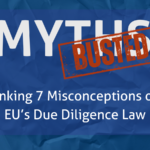The negotiations of the EU’s Energy Union Governance regulation enter the final stretch today, with representatives of the European Parliament, the Council of Ministers and the European Commission meeting for the first informal ‘trialogue’ to negotiate an agreement on the new law which should create a framework for the zero-carbon transition in the EU.
Here is all you need to know about the institutions’ negotiating mandates, with colours indicating our assessement of the positions:
Both the Council and the European Parliament has strengthened the Commission’s original proposal in their positions. The two positions are however far from each other on most aspects, with the Parliament’s position being much more ambitious.
Regarding the National Energy and Climate Plans (NECPs), the European Parliament set for a binding template for the NECPs and added into the template many important details, e.g. on phase out of fossil fuel subsidies, Member State’s national trajectories for maintaining and enhancing the carbon removals from sinks as well as trajectories and objectives for energy from renewable sources produced by cities, energy communities and self-consumers.
The Council also agreed the template should be binding, but weakened the Commission’s proposal by allowing many details to be included only “if applicable”.
Regarding how to meet the 2030 energy targets – including trajectories and how to ensure there is no ambition gap (gap avoider) or delivery gap (gap filler) – the Parliament opts for linear trajectories for efficiency and nearly linear for renewables and that any emerging gap with its trajectory is covered within one year by additional measures.
The Council downgraded the efficiency trajectory to indicative and the renewables trajectory to be made up of 3 reference points which as such is OK, but the % for the 3 points is too low to ensure delivery of the 2030 target.
Lastly, regarding the long term strategies, the Parliament opted for a more ambitious target for 2050 for both the EU and the Member States and added a planning template in an Annex.
The Council agreed that the NECPs and long term strategies must be consistent with each other, but refrained from adding any details on how the strategies should be designed and did not recognise that the current long term target is inadequate to deliver on the EU’s commitments to the Paris Agreement.
Summary table with the position of the institutions:
|
|
Commission |
Council |
Parliament |
|
NECPs |
Binding template
|
Binding template |
Binding template |
|
Several elements made unbinding
|
Added new important elements |
||
|
Deadline 1 January 2019 |
Deadline 31 December 2019
|
Deadline 1 January 2019 |
|
|
2030 trajectory renewable energy |
Linear |
3 reference points: 24% in 2023 40% in 2025 60% in 2027 |
3 reference points: 20% in 2022 45% in 2025 70% in 2027 |
|
2030 trajectory for energy efficiency |
Linear
|
Indicative |
Linear |
|
2030 “Gap avoider” |
RES: MS shall collectively ensure that the sum of their contributions add up. COM may issue recommendations
|
RES: Commission to use “objective criteria” to assess if there is a gap |
RES: Member States shall collectively ensure that the sum of their targets adds up to a linear trajectory |
|
COM may issue non-quantitative recommendations
|
COM shall issue recommendations; may request MSs pledging too low to increase ambition |
||
|
Efficiency: MS to set national indicative contributions |
Efficiency: MS to set national indicative contributions |
Efficiency: MS to set binding national targets
|
|
|
2030 “Gap filler”
|
COM may issue recommendations to all MS & shall, as appropriate, take measures at Union level. |
Commission may issue recommendations […]
|
COM shall issue recommendations […]
|
|
MS shall ensure by 2024 that any emerging gap is covered by additional measures |
MS shall ensure by 2026, 2028 and 2030, that any gap compared to their indicative Union trajectory is covered |
MS shall ensure any emerging gap with its trajectory is covered within one year by additional measures
|
|
|
Long term strategies |
With a 50 year perspective (= 2070) |
With a 30 year perspective (= 2050)
|
With a 30 year perspective (= 2050) |
|
To deliver 80-95% emission reductions by 2050
|
To deliver 80-95% emission reductions by 2050 |
To deliver net zero GHG emissions by 2050 |
|
|
No consistency guaranteed NECPs/long term strategies
|
Consistency NECPs/long term strategies required |
Consistency NECPs/long term strategies required |
|
|
No template
|
No template |
A binding template |


